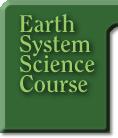Tropical
Forests Scenario
The
Rainforest
Action Network says that:
| "Rainforests
cover less than two percent of the Earth's surface, yet
they are home to some 50 to 70 percent of all life forms
on our planet. The rainforests are quite simply, the richest,
oldest, most productive and most complex ecosystems on
Earth. As biologist Norman Myers notes, 'Rainforests are
the finest celebration of nature ever known on the planet.'
And never before has nature's greatest orchestration been
so threatened." |
Frontier
Forests of the World
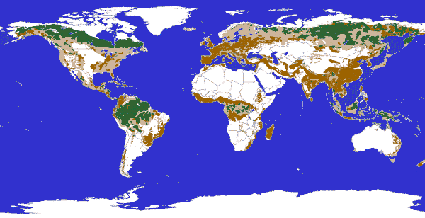
| |
|

Copyright
© 1987 World Resources Institute. All rights reserved.
|
Earth
in the Balance
In his book Earth in the Balance, Vice President Al
Gore writes that "The most dangerous form of deforestation
is the destruction of the rainforests, especially the tropical
rainforests clustered around the equator. These are the most
important sources of biological diversity on Earth and the
most vulnerable ecosystems now suffering the effects of our
determined onslaught. Indeed, as many as half of all the living
species on Earth--some experts actually claim more than 90
percent of all living species--find their homes in tropical
rainforests, and the irretrievable loss of the living species
dying along with them represent the single most serious damage
to nature now occurring. While some of the other injuries
we are inflicting on the global ecological system may heal
over the course of hundreds or thousands of years, the wholesale
annihilation of so many living species in such a breathless
moment of geological time represents a deadly wound to the
integrity of the earth's painstakingly intricate web of life,
a wound so nearly permanent that scientists estimate that
recuperation would take 100 million years." (Gore, A.,
1993).
Images
of the Amazon Region and West Central Africa
The AVHRR Normalized Difference Vegetation Index (NDVI) is
a ratio which has been shown to be highly correlated with
vegetation parameters such as leaf biomass and leaf area.
Areas with high values shown in red are areas likely to be
covered with vegetation. The last column contains the
change.jpgs that are the result of image differencing (NDVI
1981 - NDVI 1994 pseudocolor images) for the Amazon region
and for West Central Africa. Blue areas represent areas
of little or no change in the vegetation index, while yellow
and red areas represent a decrease in the vegetation index.
| The
Amazon Region |
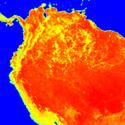 |
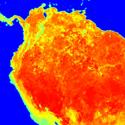 |
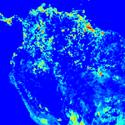 |
| 1981 |
1994 |
NDVI 1981
- NDVI 1994 |
The West
Central Region of Africa |
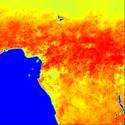 |
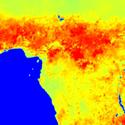 |
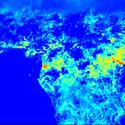 |
| 1981 |
1994 |
NDVI 1981
- NDVI 1994 |
When we
think of rainforests, Amazon is probably the first region
that comes to mind. But, the World
Resources Institute reports that nearly one-third of the
world's rainforests are in Africa, Asia, and other parts of
Latin America beyond the Amazon. Even the United States has
rainforests in Puerto Rico, Hawaii, Guam, American Samoa,
and the U.S. Virgin Islands. Judging from the images
above, rainforests in other parts of the world may be
disappearing faster than in the Amazon region.
Global
Rates of Rainforest Destruction
(Source: Deforestation Rates in Tropical Forests and Their
Climatic Implications)
- 2.47
acres (1 hectare) per second: equivalent to two U.S. football
fields
- 150
acres (60 hectares) per minute
- 214,000
acres (86,000 hectares) per day: an area larger than New
York City
- 78
million acres (31 million hectares) per year: an area larger
than Poland
These
rates of tropical deforestation raise many questions. What
happens to our planet when a rainforest disappears? What happens
to air quality when the rainforests are gone? What happens
to the soil when a rainforest disappears? What happens to
surrounding water quality when a forest is burned to make
way for farming and grazing? When the forest is gone, will
it come back? People can move to cities, but where do
the animals, birds, and insects go? Doing research to find
out about tropical deforestation can lead to learning about
biology, agriculture, rainforests, population growth, endangered
species, habitats, land use practices, global warming, weather,
climate change, and air quality.
Situation
Later this year in Brazil, an international community of scientists
and representatives from government, business, and industry
will convene an International Congress on Forest Resources.
Vice President Al Gore will represent the United States and
deliver the keynote address during the opening session. The
Whitehouse has asked NASA's Earth Science Enterprise (ESE)
to examine the cumulative effects of deforestation on Earth
systems and to draw some conclusions about the fate of the
world's rainforests and the planet itself.
ESE in
turn has contracted with your company to analyze the cause-and-effect
relationships that exist among Earth systems as a result of
rainforest destruction. The results of your analysis
will serve as the talking points for the Vice President's
keynote presentation and should include the hazards of continued
rain forest destruction and recommendations for future courses
of action with supporting Earth systems information.
Assignments
Over the next two weeks (Week A and Week B) you will work
individually and in teams to address the tropical forests
situation. Use the links below to access your assignments.
Week A: Teacher
as Problem Solver
Private
Theory Activity and Rubric
Individually,
identify what you believe to be true and the reasons for why
you have those beliefs regarding tropical forests.
Week A: Teacher
as Problem Solver
Knowledge-Building
Activity and Rubric
As
a team, build ESS knowledge about the tropical forests event
described in the scenario, and develop a problem statement.
Week B: Teacher
as Model Builder
Model-Building
Activity and Rubric
Using
your team's original or revised problem statement, build an
ESS model that includes the ESS relationship statements and
evidence that support your conclusions (recommendations or solutions).
[
Back
to Outline ]
[
Home ] [ Intro
] [ Guide ] Outline [ Classroom
]
HTML code
by Chris Kreger
Maintained by ESSC Team
Last updated July 25, 2000
Privacy
Statement and Copyright©
1997-2000 by Wheeling Jesuit University/NASA Classroom of the Future™. All
rights reserved.
|

